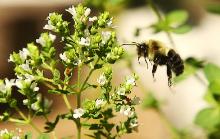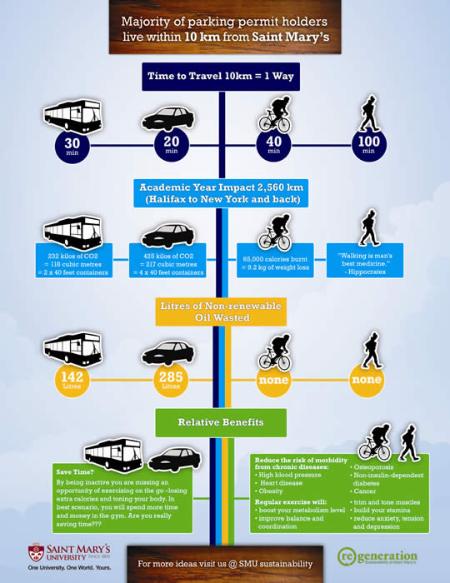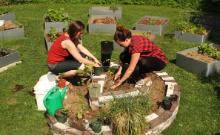Green Initiatives
Sustainability In Action
The Atrium | SMU Stars | Cleaner Greener Campus | Transportation
Community Garden | Outside Classroom | Saving the Planet
Cleaning Products | Mapping our Future
Like its signature three-storey living wall, a natural air filter that’s the first of its kind in Atlantic Canada, Saint Mary’s new Atrium/Global Learning Commons is a breath of fresh air. Designed by the Halifax firm, Davison Seamone Rickard Adams Architects, and constructed to strict Leadership in Energy and Environmental Design (LEED) standards, the 43,000 sq. ft. structure was completed last year at a cost of $17.5 million.
In matters pertaining to the health of the planet, the Atrium/Global Commons walks the green talk. The fair-trade, organic coffee shop is green; the water station is green; the carpets and furnishings are green. Even the roof is green, an experimental technology that reduces the consumption of energy, creates a natural habitat from otherwise unused space and offers Saint Mary’s researchers a unique opportunity to investigate green roof design, measure performance and support research on optimizing crop plants for biofuel feedstocks.
Saint Mary’s is committed to incorporating sustainaable building practices into small renovations and large construction projects alike. Opportunities for green building strategies are tracked through LEED, an internationally recognized green building certification system that verifies that a building has been designed and built using strategies aimed at improving energy savings, water efficiency, indoor environmental quality and stewardship of resources.
 Saint Mary’s would like to lose some weight. In fact, what we’d really like is to shed a few metric tons of CO2, a ton or so of solid waste, 500,000 litres of oil and about a million kilowatt hours. It isn’t going to be easy, but Saint Mary’s understands the value of monitoring and accountability, so we’ve signed on to the Sustainability Tracking, Assessment & Rating System™, otherwise known as STARS®, a self-reporting system that provides institutions in the United States and Canada with a standardized assessment tool to evaluate their progress toward sustainability, tracking everything from sustainability research opportunities and sustainable dining efforts to campus-wide social justice initiatives.
Saint Mary’s would like to lose some weight. In fact, what we’d really like is to shed a few metric tons of CO2, a ton or so of solid waste, 500,000 litres of oil and about a million kilowatt hours. It isn’t going to be easy, but Saint Mary’s understands the value of monitoring and accountability, so we’ve signed on to the Sustainability Tracking, Assessment & Rating System™, otherwise known as STARS®, a self-reporting system that provides institutions in the United States and Canada with a standardized assessment tool to evaluate their progress toward sustainability, tracking everything from sustainability research opportunities and sustainable dining efforts to campus-wide social justice initiatives.
STARS was launched more than a year ago by the Association for the Advancement of Sustainability in Higher Education (AASHE), a Colorado-based association of colleges and universities that works to promote sustainability by providing resources, professional development, and a network of support to enable institutions of higher education to model and advance sustainability in everything they do, from governance and operations to education and research.
The only system of its kind that involves public reporting of comprehensive information related to a college’s or university’s sustainability performance, STARS includes 139 environmental, economic, and social indicators, which are divided into four categories related to campus activities: Education & Research, Operations, Planning, Administration & Engagement, and Innovation.
As one of only 22 Canadian universities registered with STARS, Saint Mary’s has begun collecting data that fulfills the criteria for STARS credits and will submit this data through an online Reporting Tool. Based on that report, we will receive a rating of Reporter, Bronze, Silver, Gold, or Platinum. Once the University signs off on our ranking, the report will be publicly available for viewing on the STARS website and we will have a benchmarking tool to measure our sustainability program against other universities in the AASHE organization.
By providing a framework for understanding sustainability in all sectors of higher education, STARS enables meaningful comparisons over time and across institutions using a common set of measurements developed with broad participation from the campus sustainability community. The online reporting tool creates incentives for continual improvements in sustainability, facilitates the sharing of information and builds a stronger community of campus sustainability. With all of that support, we’re bound to lose some weight.

A 2007 energy study determined that there were considerable opportunities for Saint Mary’s to reduce energy and improve infrastructure. Since then the University has made a committed effort to upgrade lighting, conserve water, reduce heat loss and optimize HVAC controls.
A key part of this sustainability strategy was the 2008 conversion from oil to natural gas, a reliable and healthier, made-in-Nova Scotia solution to improving air quality and protecting the environment. While comfortably heating more than a million square feet of space, Saint Mary’s new heating plant reduces our carbon footprint by about 33%.
Saint Mary’s conversion to natural gas is a critical step toward the cleaner and greener province envisioned in Nova Scotia’s 2009 Energy Strategy. Not only has our conversion reduced our own greenhouse gas emissions by more than 2,000 tonnes a year---an amount that equals removing about 400 cars from the road---but we have also created more opportunities for others by encouraging Heritage Gas to expand its network further into Halifax.
Breakthroughs in Bikeways and Alternative Transportation
Click to download this infographic

If you build it, they will come; if you build it with a bike path, chances are they won’t arrive by car.
With this in mind, Saint Mary’s is moving towards a more bike-friendly campus and is collaborating with Capital Health, Dalhousie University and the IWK on a project to advance sustainability through better bikeways for lands owned by all four institutions. The Bikeways Plan for an area known as the Urban Halifax Institutional District has great potential to shift gears in the conventional approach to the campus commute.
At the same time that Saint Mary’s encourages innovations in sustainable transportation, we recognize that commuter cycling isn’t either practical or possible for all of our students and employees. There are, however, other alternatives to SOVs (single occupancy vehicles). Walking, carpooling and riding with Metro Transit will reduce the number of cars on the road and the campus, resulting in decreased fuel consumption, lower levels of air pollution and safer routes for pedestrians.
As an added consideration, alternative modes of transportation save more than the planet. Reduced needs for fuel, vehicle maintenance and parking permits will save money.
There are many initiatives underway at Saint Mary’s to engage students, staff and faculty to experiment with alternative modes of transportation. Facilities Management works with public transit and includes a link to the Metro Transit website on the Saint Mary’s Parking webpage. As well, there is a campus carpool program in place, there are twice as many bike racks as there were two years ago, and the Homburg Centre Gym provides showers for cyclists (showers are closed from 3pm to 5pm).
Saint Mary’s sells about 1000 parking permits each year and any reduction to that number will require removing some of the barriers identified by parking permit holders in a questionnaire distributed by Facilities Management. With distance, time, schedule and convenience cited as the greatest obstacles to alternative transportation, there is work to be done on the road to sustainability. The thing to keep in mind is that the closest parking space for most buildings on campus is a bike rack.
The University strongly encourages the university community to consider more sustainable forms of transportation such as public transit, walking, biking, or carpooling whenever possible. Visit HRM SmartTrip to arrange a carpool. The University carpool program allows members of the university community to have access to reserved carpool spaces, please see the Parking and Alternative Transportation Policy for more details.
Community Garden @ Saint Mary's University

The garden rents individual and collective gardening plots on a first come, first served basis Proceeds from the rentals are rolled back into the garden to cover the costs of workshops, equipment, supplies and future projects such as a composting centre and a spiral herb garden. Down the road the funds from rentals will help realize plans for a greenhouse and an eco-friendly garden shed constructed from recycled materials.
To encourage those who visit the garden to linger, a strategic arrangement of large rocks creates an inviting seating area. “The space was designed to double as an outdoor classroom,” says Shelley Price-Finn, of Saint Mary’s Facilities Management. “Already this summer it has been used by Geology classes studying!!!”
Produce grown in the Saint Mary’s Community Garden addresses the growing concern with the distance travelled by food on its journey from field to fork. By reducing food miles, it conserves energy and connects those involved with the abundance of our local harvest. And if that’s not enough---it tastes better!
Thinking Outside the Classroom

Some of the classrooms on the Saint Mary’s campus are for the birds---especially the 45 that were built and erected on trees to house our resident Starlings.
Like the Burke-Gaffney Observatory, the outdoor learning space behind the Oaks and the Atrium’s Green Roof and Living Wall, these birdhouses provide a unique learning environment that extends beyond the four walls of a traditional classroom.
Whether they’re taking blood samples from European Starlings, discovering a new supernova, analyzing a poem in the backyard of an historic mansion, or evaluating biodiversity in the only green roof research facility in Atlantic Canada, the students at Saint Mary’s University benefit from a campus master plan that recognizes the value of sustainability and the untapped potential in thinking outside the box.
Saving the Planet: One Page at a Time

Terri Winchcombe is known for saying, “there has to be a better way,” and she said it a year ago at the sight of paper overflowing from large blue recycling bins in the Patrick Power Library. As the library’s Manager of Acquisition Services, Terri approached University Librarian, Marie DeYoung with the idea of greening the library’s work flow for receiving new books by bar-coding and scanning the books instead of printing a page to identify each one.
“How could I say no?” asks Marie. “Terri’s initiative saves the library about 6500 pieces of paper a year.”
“We already had a bar code system,” explains Cataloguing and Metadata Librarian, Lou Duggan, “but we were using it at the end of the process instead of at the beginning.”
Lou worked with Terri to realize her concept for identifying new books and to make sure that no important data was lost in the process. The end result is a system that’s better for the library, better for library users and better for the environment.
“And we’re not stopping there,” says Terri. “There are other pieces of paper to save.”
Custodial Services Cleaning Products
In 2001 Saint Mary's University started to investigate and use green chemicals. The percentage of green chemicals used on campus at that time was very low. From 2001 to 2007 the university began trialing more and more green products, until the custodial division put out a Request for Proposal to convert dispensed products to 3rd party green certified products. Click on the icon below for a graphical representation of the percentage of green products used at Saint Mary's since 2008. Four Activeion "Ionator" products are being trialed on campus in the Atrium.
To truly becoming a leader in sustainability our students and faculty need to take ownership of our goals and make it happen. Our Blue and Green maps are great examples of how our students and faculty have taken up the challenge and are leading the way.
The Blue map, created by Ashley Shelton an Undergrad Saint Mary's University Student showcases the different hydrostations and water fountains on the Saint Mary's University Campus. The map was designed to foster and encourage student, faculty and staff towards drinking more tap water, and less bottled water and included several recommendations, many of which have already been implemented.
Saint Mary’s Department of Geography, created the Green Map with the goal of providing students, members of the Saint Mary’s community, and visitors with the information and resources that will help them live a more sustainable lifestyle on campus.
 SMU Blue Map |
 SMU Green Map |
General Inquiries
902-420-5400
University Security:
Emergencies: 902-420-5000
Non-emergency line: 902-420-5577
Cancellation/Closure Hotlines:
Students: 902-491-6263
Faculty & Staff: 902-491-6264
Go to the Campus Directory for faculty, staff and departments.